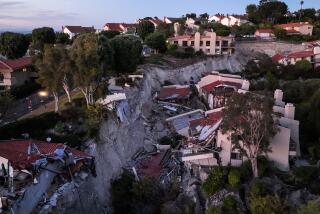SCIENCE / GEOLOGY : Study Says Pause Might Signal Volcanic Eruption
- Share via
An Arizona State University geologist who was seriously injured last year when Galeras Volcano in Colombia unexpectedly erupted while he and other scientists were studying it, reports today that Galeras and certain other volcanoes may give off a signal before erupting.
If so, according to geologist Stanley N. Williams and five other researchers writing in the British journal Nature, it may be possible to predict some eruptions.
And had they possessed the information last year, Williams, 41, and the research party he was part of would certainly have stayed away from the crater on Jan. 14, 1993, when nine people were killed in the eruption, including six scientists.
The scientists say the signal actually was a pause in sulfur dioxide emissions and long-period, or harmonic, seismicity. What they thought at the time was reassuring quiet was, in fact, an ominous calm before an immediate explosion, they wrote.
Williams led the 15-member American contingent of a team of 100 scientists from 15 countries who were on a United Nations mission to explore protection of cities such as Pasto from volcanic hazards. Pasto is a city of 300,000 that lies just five miles below the dangerous mountain.
Some of the scientists were at the bottom of the inner crater when the eruption occurred. But Williams, who had been making his way off a slope of the cone leading down from the crater rim, escaped with a fractured skull, nose and jaw, and broken legs after being hit by eruptive debris.
His recovery has lasted more than a year. On Tuesday, Williams underwent surgery on one leg, which had been shattered. He is expected to regain full use of it.
Now he and six other scientists who were at Galeras--from Arizona State, the University of Montreal and the Pasto Volcanic Observatory, believe they have unlocked secrets about the events leading up to the eruption.
“We misunderstood the situation,” Williams said in an interview this week. “We had fallen into thinking the volcano was stable when it wasn’t.”
In their article in Nature, the scientists say Galeras, like other recently eruptive volcanoes, including Mt. Pinatubo in the Philippines, Arenal Volcano in Costa Rica and Redoubt Volcano in Alaska, showed an increase in both sulfur dioxide emissions and long-period, usually low-level seismicity, in the buildup phase preceding an eruption.
At Galeras, for example, emissions of sulfur dioxide rose as high as 5,000 metric tons per day. And low-frequency earthquakes, triggered by the volcanic activity and lasting up to three minutes, occurred by the hundreds. Williams said, “It is a pattern that is very unlike other earthquakes. They rise very slowly and they last for a long period.”
But then, in the last three days before the eruption, there was “a clear drop,” or “a pause” in such activity.
“As the volcanoes approach eruption, they are sealed off as far as the escape of gases is concerned, and there is a sudden quiescence in seismicity,” Williams explained in the interview. “Internal pressure apparently builds up during this period, and then the eruption takes place.”
At Galeras, the scientists thought they were safe, because they detected little seismicity and little of what is known as degassing, or the emission of gases, particularly sulfur dioxide. But that turned out to be a bad sign. “It fooled us,” Williams said, and the Jan. 14, 1993, eruption “caused an energy release that was the highest on the mountain in three years.”
Later, by studying prior instrumental records and examining the sequence of events after the January eruption--including another eruption March 23, 1993--they were impressed by the pauses.
Watching for such pauses could become an important means of reducing volcanic dangers, the scientists believe. Although cities very close to volcanoes, such as Pasto, would still be in danger in a huge Pinatubo-like eruption, the populace could be evacuated.






